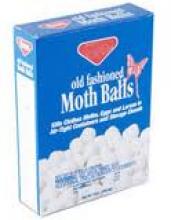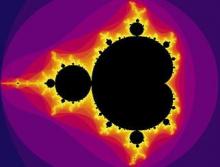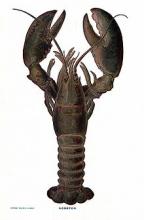
Scientists in the last one-hundred-fifty years surely have more fully explained the dispersal and speciation habits of Darwin’s finches than Darwin did after his cursory data collection on the Beagle. In his notes on the archipelago, Darwin said, “The Galápagos seems a perennial source of new things." This statement proves to be true in the case of the Galápagos finches. The ancestor of modern-day Galápagos finches probably arrived on the island in a dispersal necessary because of a catastrophic event in its original home. This ancestor adapted and eventually speciated into 13 distinct varieties spread throughout the islands. Although Darwin was incomplete or incorrect in some of his theories, modern scientists have postulated that Galápagos finches probably came to adapt into 13 unique varieties because of chance dispersal of an ancestor to and throughout the island and ecological niche competition between related varieties, as well as allopatric speciation and the founder effect.
Neither the ancient ancestor of the Galápagos finches nor its ancestral home has been found. Galápagos finches are most closely related to seed-eating tanagers found in the Caribbean, South America, and Central America. Based on geographical proximity and genetic similarity, however, the genera Tiaris, and most specifically the species Tiaris obscura, seems to be the finches’ closest living relative. Tiaris obscura is found on the South American mainland both north and south of the equator. Therefore, the most likely place of dispersal of the finches’ ancestor is the South American mainland. Other possibilities for the dispersal starting point include the Caribbean, Mexico, and Central America based on similarities between the finches and birds of those regions.
Many factors contribute to the idea that the finch, from wherever it came, probably was forced from its homeland due to a catastrophic event. No event besides a catastrophic one seems to account for the movement of the ancestor to the remote location of the archipelago. The archipelago is far from other land masses—900 kilometers from Ecuador—so it is rare that birds reach it at all. Darwin wrote that the original colonizer probably blew or drifted from the coast of South America. Other scientists, however, postulate that the ancestor may have been forced from its home due to “unusual volcanic activity in the Andes and the burning of forests…one can easily imagine large numbers of finches and other birds in coastal regions flying out to sea to escape the heat.” Again, nothing but catastrophe seems to account for the large number of members of the ancestral species which originally colonized the island. Darwin calculated that in order for the population to survive and speciate the way it had that a large number of the bird—at least 30—had to reach the island.
After the arrival of this ancestor, drastic changes began to occur on the archipelago which affected the dispersal of the original colonizers. Islands to disappeared, the difference in the distance between islands changed, and the connectedness between islands shifted due to sea level changes. Today, dispersal of finches between islands in the Galápagos is influenced by catastrophic events such as El Niño and forest fires due to volcanic eruptions, so similar events can be assumed in the dispersal history of the finches as well.
Other factors contributed to the dispersal of the finches throughout the islands. Darwin’s idea of survival competition between closely related varieties of finches seems to come into play. Darwin said the two varieties of an organism which filled the same ecological niche were in the greatest competition with each other. One of the two varieties must get rid of the other in order to survive. An exceptional individual is one who finds a new niche, or, especially in this case, island, to which it is suited. The individual can now leave the competition behind, and, if its offspring have the same favorable trait, start a new species with a new way of living or new place to live.
After breaking from its original species, the new colonizer becoming its own unique species can potentially be explained by the theories of allopatric speciation and the founder effect. Allopatric speciation occurred in the new populations as they went to their separate habitats. Allopatric speciation happens when there is geographical isolation (allopatry) of a population, followed by adaptation by that population to the new ecological conditions of a place, followed by a second phase of geographical contact (sympatry) with the sister species with no interbreeding between the old and new species. Mayr (1952) explained how the founder effect also seems to come into play in this situation. The founder effect explains why populations on large continents are more uniform than the differentiated populations on small islands. The founder effect asserts that colonization of new places is random based on genotype, but there is enough gene variation within the new population to survive it, alleles are lost to genetic drift, and alleles in new combinations are subject to natural selection. Both of these theories explain how each of the thirteen species seems to be adapted for its unique way of life as well as why finches of different species rarely interbreed, even though they do interact.
Darwin believed that once a dispersed species moved to its own island it was mostly isolated, but this doesn’t seem to be the case. There are up to seven to eight distinct species of finches on each island in the Galápagos. Biologists believe the finches may have diverged in isolation. After this isolation and divergent evolution, natural selection makes the exceptional individual adapt to a new ecological niche, and once it is no longer isolated, is removed as a threat to its closely related species. In some cases, finches simply visit other islands, dubbed by the Grants’ researchers Prince and Millington as “immatures,” visitors to an island that leave or die before the next breeding season. So, modern finch species can and do move from their isolated niches to potentially fill a similar ecological niche on another or island or simply to visit.
Some examples of interspecies relationships seem to illustrate an incomplete or transitional separation between two species, however. David Lack, a prominent biologist and researcher of Galápagos finches, collected information about the different types of finches based on differing island habitats. One study shows two differently ecologically adapted birds and an intermediary species between the two. The generus Geospiza, ground finches, breeds mostly in arid places and feeds primarily on the ground. Camarhynchus, tree finches, breed primarily in humid zones and feeds primarily in trees. However, both genera occasionally breed, within their own species, in transitional areas on the islands. After breeding season, however, the ground finches feed in the open uplands and the humid forest and the tree-finches go to arid lowlands. The most commonly found generus, Certhidea, warbler-finches, breeds throughout arid, transitional, humid forest zones and uplands, and it can be found on nearly all of the islands.
Sources and further reading:
Grant, P. and B. Grant. 2008. How and Why Species Multiply. Princeton University Press: Princeton, NJ.
Lack, D. Darwin’s Finches. 1947. Cambridge University Press: New York.
Weiner, J. 1994. The Beak of the Finch. Random House: London.







